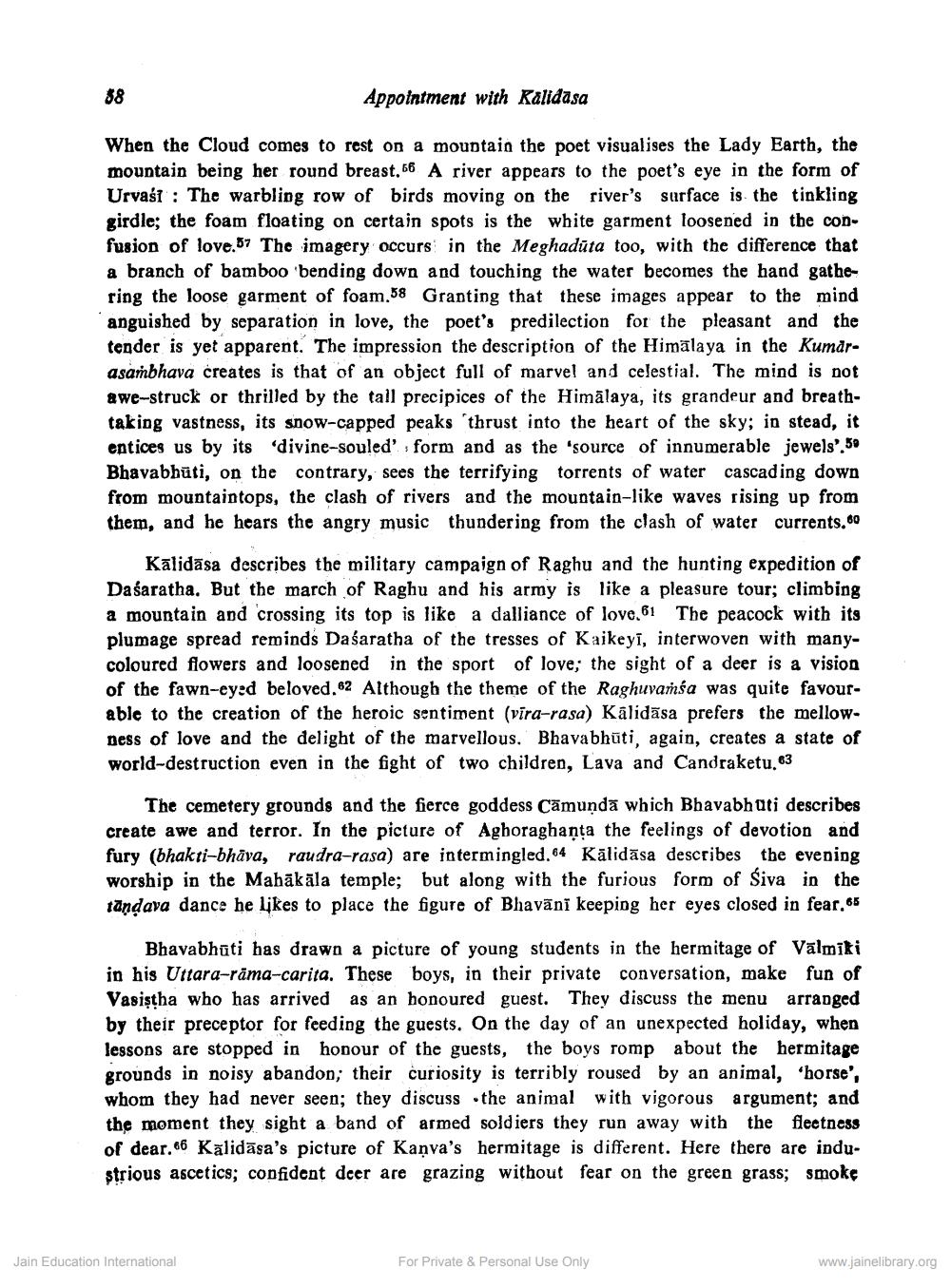________________
Appointment with Kalidasa
When the Cloud comes to rest on a mountain the poet visualises the Lady Earth, the mountain being her round breast. 56 A river appears to the poet's eye in the form of Urvasi The warbling row of birds moving on the river's surface is the tinkling girdle; the foam floating on certain spots is the white garment loosened in the confusion of love. The imagery occurs in the Meghadüta too, with the difference that a branch of bamboo bending down and touching the water becomes the hand gathering the loose garment of foam.58 Granting that these images appear to the mind anguished by separation in love, the poet's predilection for the pleasant and the tender is yet apparent. The impression the description of the Himalaya in the Kumarasambhava creates is that of an object full of marvel and celestial. The mind is not awe-struck or thrilled by the tail precipices of the Himalaya, its grandeur and breathtaking vastness, its snow-capped peaks thrust into the heart of the sky; in stead, it entices us by its 'divine-souled' form and as the 'source of innumerable jewels'.50 Bhavabhuti, on the contrary, sees the terrifying torrents of water cascading down from mountaintops, the clash of rivers and the mountain-like waves rising up from them, and he hears the angry music thundering from the clash of water currents."0
58
Kalidasa describes the military campaign of Raghu and the hunting expedition of Dasaratha. But the march of Raghu and his army is like a pleasure tour; climbing a mountain and crossing its top is like a dalliance of love.61 The peacock with its plumage spread reminds Dasaratha of the tresses of Kaikeyi, interwoven with manycoloured flowers and loosened in the sport of love; the sight of a deer is a vision of the fawn-eyed beloved. Although the theme of the Raghuvansa was quite favourable to the creation of the heroic sentiment (vira-rasa) Kalidasa prefers the mellowness of love and the delight of the marvellous. Bhavabhūti, again, creates a state of world-destruction even in the fight of two children, Lava and Candraketu.3
The cemetery grounds and the fierce goddess Camunda which Bhavabhuti describes create awe and terror. In the picture of Aghoraghanta the feelings of devotion and fury (bhakti-bhava, raudra-rasa) are intermingled.44 Kalidasa describes the evening worship in the Mahäkäla temple; but along with the furious form of Siva in the tandava dance he likes to place the figure of Bhavani keeping her eyes closed in fear,"
Bhavabhuti has drawn a picture of young students in the hermitage of Valmiki in his Uttara-rama-carita. These boys, in their private conversation, make fun of Vasistha who has arrived as an honoured guest. They discuss the menu arranged by their preceptor for feeding the guests. On the day of an unexpected holiday, when lessons are stopped in honour of the guests, the boys romp about the hermitage grounds in noisy abandon; their curiosity is terribly roused by an animal, 'horse", whom they had never seen; they discuss the animal with vigorous argument; and the moment they sight a band of armed soldiers they run away with the fleetness of dear. Kalidasa's picture of Kanva's hermitage is different. Here there are industrious ascetics; confident deer are grazing without fear on the green grass; smoke
Jain Education International
For Private & Personal Use Only
www.jainelibrary.org




